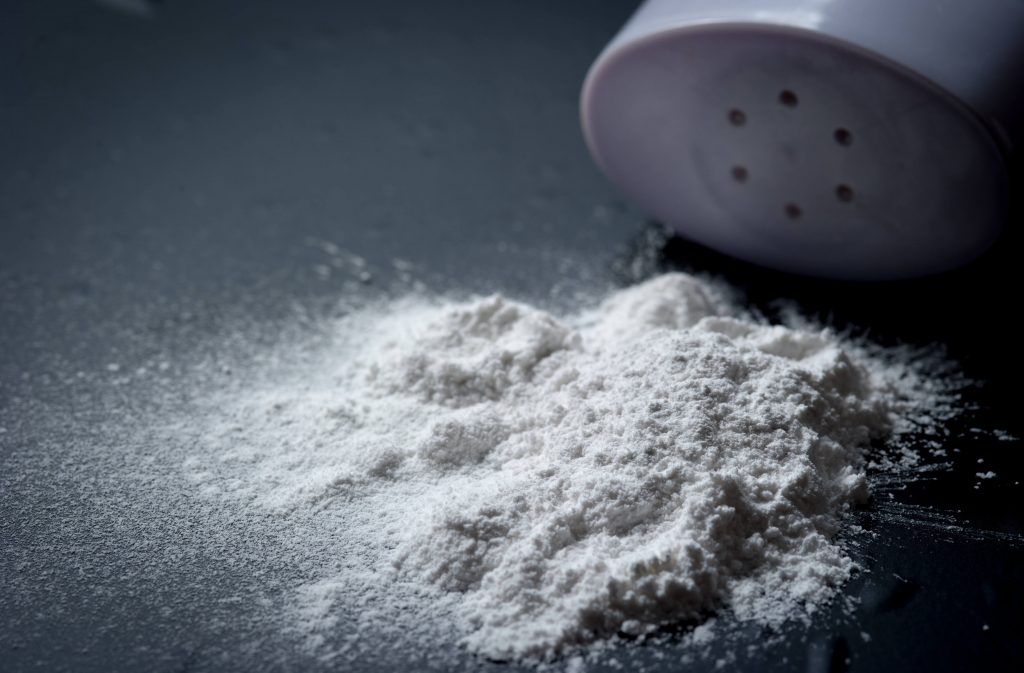Billion Dollar Settlement Secured to Help Current and Future Claimants

Talcum powder, heavily marketed as a symbol of freshness and care, found its way into millions of residences for personal care over the last few decades. It was advertised as safe to use on infants and for everyone’s use on the entire body. It was marketed as safe and hygienic. Yet, beneath the veil of this clever marketing was a dangerous reality.
Some talc, in its unrefined form, contained asbestos—a known carcinogen. Johnson & Johnson, a brand that many placed unwavering trust in, allegedly was aware of the contamination in their iconic Baby Powder and Shower to Shower® products. But rather than pulling back the curtain on the dangers, which included serious conditions affecting women such as ovarian cancer, fallopian tube cancer, and mesothelioma, they chose, it seems, a path of concealment. This secrecy betrayed countless women who had innocently believed in the product’s safety, leading many into dire health predicaments.
A Timeline of Purposeful Deceit by Johnson & Johnson
The 1950s marked the beginning of a narrative that would eventually taint the legacy of one of the world’s most trusted brands, Johnson & Johnson (J&J). In the late 1950s, alarm bells silently rang within the company when a consulting lab identified contaminants in the talc supplied by J&J’s Italian partner. These were not just any contaminants—they were described as being consistent with a type of asbestos, a known carcinogen.
Fast forward to 1967, the company encountered another unsettling discovery: traces of minerals, which can metamorphose into asbestos, were found in its own Vermont talc mine. Despite these early warnings, J&J chose a path of apparent denial. In 1971, when the FDA initiated a probe into the presence of asbestos in cosmetic talc, sparked by concerns raised in New York City, J&J staunchly defended the purity of its baby powder. And yet, for the next several years, despite their public assurances, internal tests allegedly detected asbestos in their talc, a stark revelation brought to light years later.
It’s significant to note that by 1973, J&J was actively seeking patents on a process aimed at purging asbestos from talc. This move insinuated the company’s internal acknowledgment of the issue, even if they were not vocal about it to the public. A couple of years later, J&J provided assurance to the FDA that they had found no traces of asbestos in its talc, between December 1972 and October 1973. By 1980, perhaps as a precautionary move, J&J began offering an alternative – a cornstarch formulation of its Baby Powder.

1999 marked a significant turn of events. A woman who was diagnosed with mesothelioma initiated legal proceedings against J&J. Though her case would ultimately be dropped, it planted the seed for the wave of litigation that was to follow. Ten years later, in 2009, when more scientific studies and evidence of J&J’s knowledge became clear, legal challenges against J&J alleged that its talcum products led to different types of cancer in thousands of women.
From then on, a succession of lawsuits saw the courts ordering J&J to pay substantial sums in damages. By 2018, the payout reached a staggering $4.69 billion, resulting in a deluge of new claims. Amid mounting legal pressure and evident safety concerns, J&J strategically decided to cease the sales of its talc baby powder in North America by May 2020.
Throughout this saga, one thing is clear: the power of collective action and the relentless spirit of the affected individuals have forced a corporate behemoth to acknowledge its alleged missteps. Litigations of this magnitude don’t just represent individual claims—they epitomize a call for societal change, urging corporations and regulators to prioritize safety over profits. The protracted litigation against J&J is testament to the power that individuals hold when they band together. This story reminds us that in the face of adversity, when the public unites with a sense of purpose, even the mightiest corporation will change its practices and products.
The Power of Watts: A $12.08 Billion Settlement
Amidst the betrayal felt by affected women and their families, mass tort attorney Mikal C. Watts and the legal team of Watts Law Firm LLP began taking on clients who have been injured or killed from mesothelioma, cancer and other diseases as a result of their trusting J&J that the use of talc powder products was safe. Refusing to be silenced or intimidated by a pharmaceutical giant, Watts Law Firm LLP believed in the might of collective action and knew that when individuals come together, they can usher in momentous societal changes.
Their fierce determination culminated in April 2023, when Watts Law Firm LLP announced a massive settlement with Johnson & Johnson (J&J) to resolve all talc claims. The proposed agreement aims to address the overarching talc-related liabilities of both J&J and its newly established subsidiary, LTL Management LLC (LTL).
This resolution entails allocating a sum of $12.08 billion over a quarter-century to compensate women diagnosed with gynecologic cancers and mesothelioma. Valued at a net present amount of $8.9 billion, this settlement will be incorporated into a Bankruptcy Restructuring Plan. If the Bankruptcy Court confirms the proposed settlement and it gains approval from at least 75% of talc claimants, the settling defendants will allocate $12.08 billion to a newly-established Talc Trust over 25 years. Those claimants who, before April 1, 2023, were diagnosed and sought legal representation, alleging J&J’s talc products caused their gynecologic cancers or mesothelioma, will receive their settlements from the Talc Trust within a year of the plan’s confirmation. Subsequent claimants will receive disbursements from the Trust over the remaining term.

Under the leadership of Mikal C. Watts, a significant majority of law firms handling talc claims nationally have endorsed this settlement approach. Mikal commented that this lawsuit wasn’t just about money; it was about sending a message – a message that negligence, especially when it compromises human lives, will not be tolerated.
Mikal released a statement to the press, “Our job is to get our clients restitution for their injuries, and this settlement is the culmination of over a decade of fighting for justice.” This record settlement, which is set to compensate victims over the next 25 years, is not just a victory for the claimants, but a testament to the power of collective resolve.
Empower Your Talcum Powder Claim
Beyond Compensation: The Societal Ripple Effect of Mass Torts
As Mikal noted, the lawsuits weren’t just about compensation; they were about igniting change. Mass tort litigation, as seen in this case, is not only a pathway to justice for individual claimants but also a powerful tool that challenges corporations and pushes them to re-evaluate their practices. Through collective efforts, victims shine a spotlight on corporate negligence, often prompting regulatory bodies like the FDA to take action, even if belatedly.
In fact, it’s not uncommon for regulatory interventions to follow, rather than precede, mass tort litigations. While ideally, it should be regulatory bodies leading the charge in ensuring product safety, in reality, it’s often the united voices of affected individuals that sound the alarm, pushing these entities to act. This talc litigation exemplifies the enormous impact collective legal action can have, not only in securing justice for the affected but in fostering a safer environment for all consumers.
FAQs About Talc Litigation and the Settlement Against Johnson & Johnson
Who is eligible to have a claim in the talc litigation – or is the lawsuit over?
The litigation has reached a settlement in 2023, but that does not mean people cannot still file claims. A multi-billion dollar trust has been established, and people who did not previously file a claim may still be a part of this litigation. If you or a loved one regularly used body powder containing Johnson & Johnson’s® Baby Powder or Shower to Shower® and have been diagnosed with a gynecologic cancer like ovarian cancer, fallopian tube, endometrial, peritoneal, uterine, cervical, vaginal cancer or mesothelioma in or after 2000, then you might qualify to participate. Do not hesitate to reach out to our law firm to discuss your situation.
What types of injury, cancer or other diseases can a person have a claim for in the talc litigation?
Clients may recover damages associated with gynecologic cancer like ovarian cancer, fallopian tube, endometrial, peritoneal, uterine, cervical, vaginal cancer or mesothelioma. If you or a loved one regularly used body powder containing Johnson & Johnson’s® Baby Powder or Shower to Shower® and were diagnosed with one of these diseases after the year 2000, contact us to review your situation.
Can I file a lawsuit on behalf of a loved one who died from cancer?
If your loved one has passed away from a diagnosis of gynecologic cancer like ovarian cancer, fallopian tube, endometrial, peritoneal, uterine, cervical, vaginal cancer or mesothelioma, the decedent’s descendants and/or beneficiaries may have a claim on their behalf. They must have used Johnson & Johnson’s® Baby Powder or Shower to Shower® on a regular basis. If this is your situation and you’d like to know more about filing claims for loved ones who passed away, reach out to us for a case review.
When loved ones step forward to file claims on behalf of their deceased relatives, it becomes more than just a pursuit of justice; it’s a heartfelt tribute. By taking such action, they not only honor the memory of their cherished ones but also play an integral role in safeguarding others from experiencing similar tragedies. Their bravery and commitment to righting wrongs can be instrumental in driving change, ensuring that no more innocent lives are lost in the same manner.
Disclaimer: This page is for informational purposes only and does not constitute legal advice.
Empower Your Talcum Powder Claim

Mikal Watts
Mikal C. Watts is Board-Certified in Personal Injury Trial Law by the Texas Board of Legal Specialization and is a Martindale-Hubbel AV Rated Lawyer.





